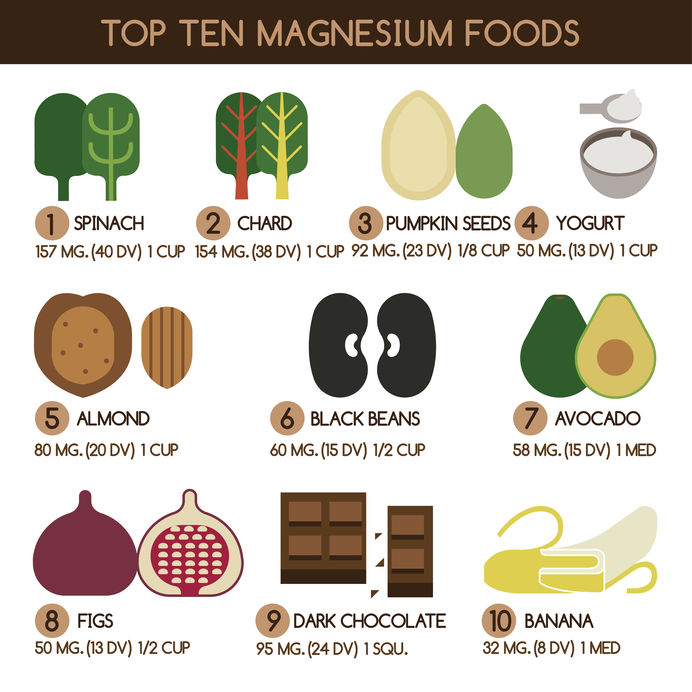
Magnesium is a mighty little mineral. It helps in hundreds of biological processes throughout the body. It’s the body’s natural chill pill, as it helps you relax and overcome the negative aspects of stress.
It’s unfortunately all too easy to become magnesium deficient
The main reasons for magnesium deficiency are:
- Our crops are grown in soil that is severely nutrient-depleted. Soil that does not contain magnesium grows crops that do not contain magnesium. Further, the industrial processing of food strips most or all of any nutrients that are in the grains and other inputs that create industrial food products.
- Many classes of commonly prescribed medications, both prescription and over-the-counter, strip our bodies of this critical mineral.
- Stress depletes our bodies of magnesium.
This 1-2-3 punch creates a perfect storm for many of the chronic diseases we experience on a global scale to flourish. Magnesium deficiency coupled with too much calcium (read this article to learn why calcium may not be so good for you after all) leads to the chronic inflammation that is the underlying cause of such disease as:
- Heart Disease
- Arthritis
- Inflammatory Bowel Disease
- Acid reflux
- Diabetes
- Hypertension (High Blood Pressure)
- Osteoporosis
- Cancer
- And more
Other ways our bodies are depleted of magnesium include:
- Excessive alcohol consumption
- Calcium supplementation
- Excessive coffee consumption
- High sugar intake
- High cortisol levels from stress or poor sleep habits
- Malabsorption and poor digestion, such as Crohn’s disease, IBS, Celiac disease, Leaky Gut, dieting
Before diseases manifest, our bodies give us plenty of other warning signs that magnesium is running low. Some magnesium-deficiency cues include:
- Arrythmia, atrial fibrillation, irregular contraction and rapid heart rate
- Asthma. Magnesium can help bronchodilation, which eases breathing
- Migraines, insomnia, anxiety, brain fog, depression and even suicidal thoughts
- Headaches, migraines, muscle aches and cramps, fibromyalgia
- High Blood pressure
- In women, magnesium deficiency can lead to PMS, menstrual cramps, mood swings, irritability, and osteoporosis
- In children, low magnesium is a major cause of attention deficit disorders, including ADHD or Attention Deficit/Hyperactivity Disorder
*If you or a loved one are suffering from severe depression, suicidal thoughts, ADHD or any other major medical condition, see a doctor. And arm yourself with the knowledge that magnesium and other nutritional therapies can be important allies in treating the underlying causes of these debilitating conditions.
At this point, you may be wondering how to get more magnesium into your diet. Luckily, foods that provide magnesium are also delicious! Here is a list of foods that are high in magnesium (always be sure to choose organic foods when possible, as they have been shown to generally have higher vitamin and mineral contents and won’t contain the toxic herbicides and pesticides that are detrimental to our health. Read more about organic foods here):

- Dark Chocolate. I put this one first to get your attention! Dark chocolate in both bar form and as a powder (cocoa powder) are great sources of magnesium. The higher the cocoa content, the healthier it is for you. Watch the sugar content as too much sugar depletes the body of its much-needed magnesium.
- Avocados. This delicious fruit is also high in potassium, Vitamin K, and heart-healthy monounsaturated fats.
- Almonds, cashews and brazil nuts. Try soaking nuts in salt-water overnight and then dehydrating in a dehydrator or an oven set to the lowest temp till they are crispy. This simple process makes them easier to digest with more bio-available nutrients, as well as crispier and even more delicious.
- Legumes. Magnesium-rich lentils, chickpeas, and beans are also high in potassium, fiber and iron.
- Leafy Greens. Spinach, chard, kale, mustard greens, beet greens, arugula, the list of leafy greens is a long one. Be sure to eat a wide variety of greens. Leafy greens are healthiest when cooked: sauteed, fried, steamed, or added to soup. Cooking greens helps to neutralize the oxalic acid that prevents absorption of the many nutritional components they contain.
This is a time when supplementation is a critical part of the protocol. Although the foods listed above and many others do contain magnesium, as previously mentioned knowing how much any given food contains is based on guess work at best. Our depleted soils and industrial food system render many otherwise-healthy food choices devoid of any meaningful nutrition. And as I hope is clear by now, getting enough magnesium is a foundational aspect to overall health and vitality. I recommend the following magnesium supplements to my clients:
Natural calm magnesium. There are different flavors you can try, but be sure to get the plain magnesium. Don’t get the kind with calcium (read this post to learn why supplemental calcium is actually very bad for you) or with melatonin (read this post to learn why supplemental melatonin is not a good idea).
ReMag Pico Ionic Liquid Magnesium. This is probably the best magnesium supplement available today. The taste can be a bit off-putting, but I just shoot it down in a little water because it’s so effective.
MagSRT Slow Release Magnesium. For those who find pills easier to swallow, this is an excellent option.
Magnesium is a critical mineral to our overall health and vitality. Make sure you are getting enough to sleep better, be more relaxed, and have the energy you deserve to live the life you want!